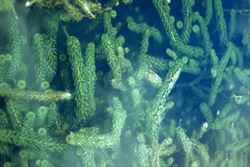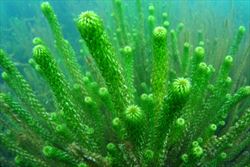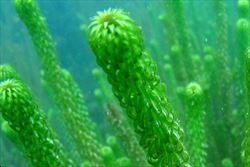Click on images to enlarge

infestation (Photo: Trevor James)

habit (Photo: Trevor James)

reflexed leaves (Photo: Trevor James)
Scientific Name
Lagarosiphon major (Ridl.) Moss
Synonyms
Elodea crispa hort. ex HenkelLagarosiphon muscoides Harv. var. major Ridl.
Family
Hydrocharitaceae
Common Names
African oxygen weed, African elodea, coarse oxygen weed, curly water thyme, lagarosiphon, oxygen plant, oxygen weed, oxygen-weed, South African oxygen weed
Origin
Native to central and southern Africa (i.e. Zambia, Zimbabwe, Botswana, Lesotho and South Africa).
Cultivation
Lagarosiphon (Lagarosiphon major) has been cultivated in Australia as an aquarium plant, but is no longer known to be deliberately cultivated.
Naturalised Distribution
Naturalised in the coastal districts of northern New South Wales and sparingly naturalised in Tasmania. Small infestations reported near Melbourne, in Victoria, and Newcastle, in New South Wales, were eradicated in the late 1970s.
Possibly also naturalised in Victoria and naturalised overseas in Europe (e.g. the UK, Austria, France, Germany, Italy, Portugal, Spain and Switzerland), New Zealand and the Mascarenes (e.g. La Réunion).
Habitat
A potential weed of slow-moving waterways, ponds, lakes and dams in the temperate regions of Australia.
Habit
A submerged, long-lived (i.e. perennial), freshwater plant with stems that are usually rooted to the substrate. It also produces creeping underground stems (i.e. rhizomes).
Distinguishing Features
- a submerged aquatic plant with stems up to 5 m long that are usually rooted to the substrate.
- its small strap-like leaves (5-20 mm long and 2-3 mm wide) are densely arranged in a spiralling pattern along the stems.
- these leaves are strongly bent downwards and have minute teeth along their margins.
- its tiny flowers are pink or purplish in colour and borne just above the water surface on long thread-like stalks.
Stems and Leaves
The fragile stems are much-branched, slender (3-5 mm thick), and up to 5 m long. They are produced off the creeping underground stems (i.e. rhizomes) and grow up towards the water surface. The stem joints (i.e. nodes) and leaves are wider apart near the base of the stems but become more crowded towards their tips. Roots (i.e. adventitious roots) are produced from near the base of these stems, at their lowermost joints (i.e. nodes).
The elongated and strap-like leaves are alternately arranged along the stems in a distinctive spiralling pattern. These leaves (5-20 mm long and 2-3 mm wide) are stalkless (i.e. sessile) and are densely clustered towards the tips of the branches. They are strongly curved downwards (i.e. reflexed) and have minute teeth along their margins.
Flowers and Fruit
Separate male and female flowers are produced on separate plants (i.e. they are dioecious), and only female plants are found in Australia. Both types of flowers are small (less than 3 mm across) and borne in the upper leaf forks (i.e. axils). The female flowers are borne singly on a long thread-like stalk (i.e. filamentous hypanthium). They are pink or purplish in colour and have six minute 'petals' (i.e. perianth lobes or tepals). Flowering occurs mostly during summer and early autumn.
As male plants are not present in Australia, fruit and seeds are not produced here.
Reproduction and Dispersal
All reproduction is vegetative (i.e. asexual) in Australia, via stem fragments and creeping underground stems (i.e. rhizomes).
The creeping underground stems (i.e. rhizomes) allow colonies of this weed to increase in size and spread laterally across or along a water body. Stem fragments are usually introduced into new water bodies in dumped aquarium waste are spread down catchments by water movement and floods.
Environmental Impact
Lagarosiphon (Lagarosiphon major) is regarded as an emerging environmental weed in Tasmania, and as a potential environmental weed or "sleeper weed" in many parts of southern Australia. It is also on the "Alert List for Environmental Weeds", a list of 28 non-native plants that have the potential to seriously degrade Australia's ecosystems which are currently in the early stages of establishment.
Lagarosiphon (Lagarosiphon major) grows extremely quickly from the bottom waterbodies and forms dense mats of vegetation several metres thick at or just below the water surface. It will withstand low light levels, and can grow in water more than 6 m deep. Its canopy spreads out across the upper levels of a waterbody, thereby shading out and out-competing other underwater species. Lagarosiphon (Lagarosiphon major ) can dominate freshwater lakes, dams and slow-moving streams and has the potential to become a troublesome weed of such habitats throughout the temperate and sub-tropical regions of Australia.
Dense infestations are generally produced in nutrient-enriched waters. Such infestations can block light penetration, out-competing and displacing native water plants and affecting associated populations of aquatic invertebrates. They can also deplete oxygen levels in the water, thereby making waterbodies less habitable by native fish and waterbirds.
Lagarosiphon (Lagarosiphon major) is a significant problem weed in New Zealand, where it completely dominates waterbodies, preventing their use for recreational activities such as swimming, boating and fishing. It has an early competitive advantage which allows it to successfully out-compete native species such as milfoils (Myriophyllum spp.) and pondweeds (Potamogeton spp.). Lagarosiphon (Lagarosiphon major) is also well established in the UK, where it has displaced other introduced waterweeds in recent years including elodea (Elodea canadensis) and Nuttall’s pondweed (Elodea nuttallii).
Other Impacts
Lagarosiphon (Lagarosiphon major) can impede the passage of boats on infested waterways and can interfere with recreational activities like swimming and fishing. Dense infestations can also increase the impact of flooding and can interefere with electricity generation in hydro-electric power plants. For example, in 1968, lagarosiphon (Lagarosiphon major) caused a power outage when it blocked the intake screens at the Aratiatia hydro-electric power station in New Zealand.
Legislation
This species is declared under legislation in the following states and territories:
- ACT: C1 - notifiable pest plant (a pest plant whose presence must be notified), and C4 - prohibited pest plant (a pest plant whose propagation and supply is prohibited).
- New South Wales: Class 1- a state prohibited weed. The presence of the weed on land must be notified to the local control authority and the weed must be fully and continuously suppressed and destroyed (throughout the entire state).
- Northern Territory: C - not to be introduced into the Territory.
- Queensland: Class 1 - introduction into the state is prohibited, and landowners must take reasonable steps to keep land free of this species (throughout the entire state). It is also illegal to sell a declared plant or its seed in this state.
- South Australia: 1@ - this species is declared in Class 1a, a category for prohibited aquatic weeds. Its presence must be notified and the plant must be destroyed (throughout the entire state).
- Tasmania: D - the importation or sale of this species is prohibited and measures to reduce its population in an area, eradicate it from an area, or restrict it to a particular area may be required.
- Victoria: S - prohibited and is to be eradicated from the state if possible.
- Western Australia: P1 - trade, sale or movement into the state prevented, and P2 - to be eradicated (throughout the entire state).
Management
For information on the management of this species see the following resources:
- the Biosecurity Queensland Fact Sheet on this species, which is available online at http://www.dpi.qld.gov.au.
- the Victorian Department of Sustainability and Environment Landcare Note on this species, which is available online at http://www.dse.vic.gov.au.
- the Northern Territory Department of Natural Resources, Environment and The Arts Agnote on this species, which is available online at http://www.nt.gov.au/weeds.
Similar Species
Lagarosiphon (Lagarosiphon major) can be confused with other submerged water weeds such as dense waterweed (Egeria densa), elodea (Elodea canadensis), hydrilla (Hydrilla verticillata), hornwort (Ceratophyllum demersum), cabomba (Cabomba caroliniana) and parrot's feather (Myriophyllum aquaticum). Hydrilla (Hydrilla verticillata) and hornwort (Ceratophyllum demersum) are native to large parts of Australia. These species can be differentiated by the following differences:
- lagarosiphon (Lagarosiphon major) has elongated (i.e. strap-like) leaves that are bent backwards (i.e. strongly recurved) and have very finely toothed (i.e. serrulate) margins. These leaves are somewhat crowded along the stems, stalkless (i.e. sessile), and alternately arranged in a distinctive spiralling pattern. Its inconspicuous pink or purplish flowers are very small (only 3 mm across) with six tiny 'petals' (i.e. perianth segments) and are borne on the water surface on long stalks.
- dense waterweed (Egeria densa) has elongated (i.e. strap-like) leaves with very finely toothed (i.e. serrulate) margins. These leaves are densely crowded along the stems, stalkless (i.e. sessile), and usually arranged in groups (i.e. whorls) of four or five. Its flowers are relatively large with three broad white petals (9-12 mm long) and are borne on the water surface on relatively short 'stalks' (2.5-7.5 cm long).
- elodea (Elodea canadensis) has oblong or elongated (i.e. strap-like) leaves with very finely toothed (i.e. serrulate) margins. These leaves are less crowded, stalkless (i.e. sessile), and usually arranged in groups (i.e. whorls) of three. Its white flowers are relatively small with three slender petals (up to 5 mm long) and are borne on the water surface on long 'stalks' (up to 30 cm long).
- hydrilla (Hydrilla verticillata) has elongated (i.e. strap-like) leaves with very finely toothed (i.e. serrulate) margins. These leaves are less crowded, stalkless (i.e. sessile), and usually arranged in groups (i.e. whorls) of four to six. Its inconspicuous greenish flowers are very small (only 3 mm across) with six tiny 'petals' (i.e. perianth segments) and are borne on the water surface on long stalks.
- hornwort (Ceratophyllum demersum) has finely-divided leaves that are arranged in groups (i.e. whorls) of seven to twelve and are stalkless (i.e. sessile). Its inconspicuous greenish flowers are very small and enclosed in several see-through (i.e. transparent) bracts. These flowers are stalkless (i.e. sessile) and borne below the water surface in the leaf forks (i.e. axils).
- cabomba (Cabomba caroliniana) has finely-divided, fan-shaped leaves that are usually paired (i.e. oppositely arranged) and borne on stalks (i.e. petioles) up to 30 mm long. Its white flowers are relatively large with six broad 'petals' (i.e. perianth segments) 4-10 mm long and are borne just above the water surface on short stalks (1-4 cm long).
- parrot's feather (Myriophyllum aquaticum) has finely-divided leaves that narrow towards their tips and are arranged in groups (i.e. whorls) of four to six along the stems. The leaves and stems usually emerge some distance (i.e. up to 10 cm or more) above the water surface. Its inconspicuous greenish or yellowish coloured flowers are very small with four 'petals' (actually sepals) and are borne on short stalks in the leaf forks (i.e. axils).

